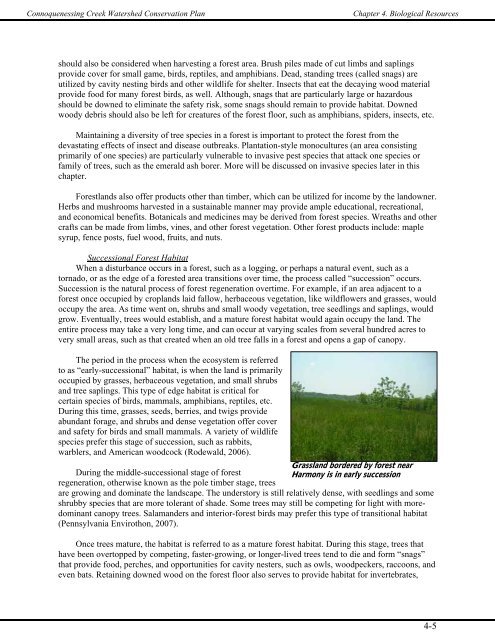CHAPTER 4 - Western Pennsylvania Conservancy
CHAPTER 4 - Western Pennsylvania Conservancy
CHAPTER 4 - Western Pennsylvania Conservancy
You also want an ePaper? Increase the reach of your titles
YUMPU automatically turns print PDFs into web optimized ePapers that Google loves.
Connoquenessing Creek Watershed Conservation Plan<br />
Chapter 4. Biological Resources<br />
should also be considered when harvesting a forest area. Brush piles made of cut limbs and saplings<br />
provide cover for small game, birds, reptiles, and amphibians. Dead, standing trees (called snags) are<br />
utilized by cavity nesting birds and other wildlife for shelter. Insects that eat the decaying wood material<br />
provide food for many forest birds, as well. Although, snags that are particularly large or hazardous<br />
should be downed to eliminate the safety risk, some snags should remain to provide habitat. Downed<br />
woody debris should also be left for creatures of the forest floor, such as amphibians, spiders, insects, etc.<br />
Maintaining a diversity of tree species in a forest is important to protect the forest from the<br />
devastating effects of insect and disease outbreaks. Plantation-style monocultures (an area consisting<br />
primarily of one species) are particularly vulnerable to invasive pest species that attack one species or<br />
family of trees, such as the emerald ash borer. More will be discussed on invasive species later in this<br />
chapter.<br />
Forestlands also offer products other than timber, which can be utilized for income by the landowner.<br />
Herbs and mushrooms harvested in a sustainable manner may provide ample educational, recreational,<br />
and economical benefits. Botanicals and medicines may be derived from forest species. Wreaths and other<br />
crafts can be made from limbs, vines, and other forest vegetation. Other forest products include: maple<br />
syrup, fence posts, fuel wood, fruits, and nuts.<br />
Successional Forest Habitat<br />
When a disturbance occurs in a forest, such as a logging, or perhaps a natural event, such as a<br />
tornado, or as the edge of a forested area transitions over time, the process called “succession” occurs.<br />
Succession is the natural process of forest regeneration overtime. For example, if an area adjacent to a<br />
forest once occupied by croplands laid fallow, herbaceous vegetation, like wildflowers and grasses, would<br />
occupy the area. As time went on, shrubs and small woody vegetation, tree seedlings and saplings, would<br />
grow. Eventually, trees would establish, and a mature forest habitat would again occupy the land. The<br />
entire process may take a very long time, and can occur at varying scales from several hundred acres to<br />
very small areas, such as that created when an old tree falls in a forest and opens a gap of canopy.<br />
The period in the process when the ecosystem is referred<br />
to as “early-successional” habitat, is when the land is primarily<br />
occupied by grasses, herbaceous vegetation, and small shrubs<br />
and tree saplings. This type of edge habitat is critical for<br />
certain species of birds, mammals, amphibians, reptiles, etc.<br />
During this time, grasses, seeds, berries, and twigs provide<br />
abundant forage, and shrubs and dense vegetation offer cover<br />
and safety for birds and small mammals. A variety of wildlife<br />
species prefer this stage of succession, such as rabbits,<br />
warblers, and American woodcock (Rodewald, 2006).<br />
During the middle-successional stage of forest<br />
regeneration, otherwise known as the pole timber stage, trees<br />
Grassland bordered by forest near<br />
Harmony is in early succession<br />
are growing and dominate the landscape. The understory is still relatively dense, with seedlings and some<br />
shrubby species that are more tolerant of shade. Some trees may still be competing for light with moredominant<br />
canopy trees. Salamanders and interior-forest birds may prefer this type of transitional habitat<br />
(<strong>Pennsylvania</strong> Envirothon, 2007).<br />
Once trees mature, the habitat is referred to as a mature forest habitat. During this stage, trees that<br />
have been overtopped by competing, faster-growing, or longer-lived trees tend to die and form “snags”<br />
that provide food, perches, and opportunities for cavity nesters, such as owls, woodpeckers, raccoons, and<br />
even bats. Retaining downed wood on the forest floor also serves to provide habitat for invertebrates,<br />
4-5














